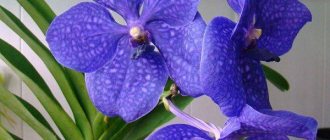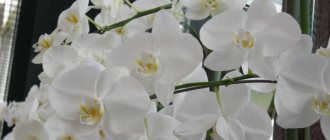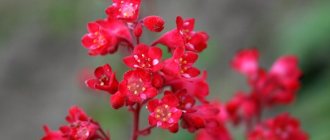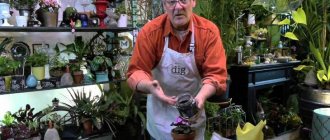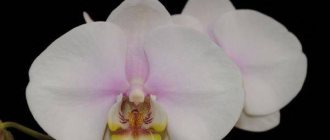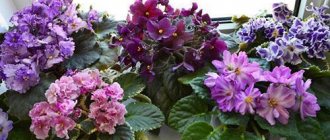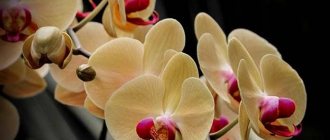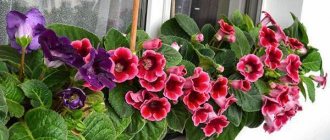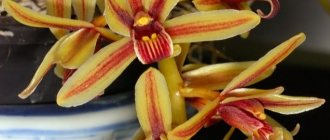Gloxinia Cleopatra (also called Sinningia beautiful) is a perennial indoor plant that is very popular among gardeners. Gloxinia belongs to tropical plants of the Gesneriaceae family and, like other ornamental flowering plants of this family, is distinguished by long-lasting flowering and attractive appearance.
Description of gloxinia and its types, recommendations for those who want to buy this flower
The houseplant gloxinia (sinningia) is a perennial herbaceous plant of small height, with a tuberous rhizome, and belongs to the Gesneriaceae.
Gloxinia looks like this: green thick, wide velvety leaves with a charming soft smell have juicy petioles, and the flowers are shaped like beautiful bells or shoes, located on peduncles of varying lengths. They have a very diverse range of colors, ranging from white to purple. They can be simple or terry, have a border or frills along the edge, as well as a speckled inner surface.
Flowering of indoor gloxinia usually begins in March and ends in April. The homeland of the plant is Brazil. Europe saw this flower only at the beginning of the nineteenth century. The language of flowers, created in the East to express feelings, designated gloxinia as “love at first sight.” It has been noticed that it has the ability to relieve stress after tiring work.
general information
Gloxinia is an indoor flower. Otherwise it is called sinningia. This is a herbaceous perennial plant. It has rhizomes in the form of tubers and is a representative of the Gesneriaceae family.
The leaves are velvety, grow in breadth, and are moderately thick. The leaves give off a pleasant, delicate scent. Gloxinia has very beautiful flowers. Each flower looks like bells or shoes. They are located on peduncles of different lengths. Flowers come in a wide range of shades. Color may vary.
For example, it can be white, pink, lilac, red, etc. Among all the variety of plants, there are simple varieties, terry ones. Along the edges of the flowers there is a border, a neat frill. The surface inside is strewn with specks of a darker or lighter color. The flowering period usually occurs in March and April.
Gloxinia is native to South America (Brazil). In European countries they became acquainted with the flower only in the 19th century.
In order for people to express their feelings, the language of flowers was invented in eastern countries. The meaning of gloxinia is love that occurs at first sight. Therefore, the plant is used as a kind of love talisman that brings peace and harmony to relationships.
The plant has an unusual ability. It helps in relieving fatigue and tension in a person who has been engaged in monotonous physical or mental work for a long time.
Its varieties are incredible in their coloring. The catalog, which presents all the options, can be seen on the website of Svyatoslav Siletsky. He collected all the specimens, even the plants that breeders came up with in 2015.
The most common types of gloxinia, names of varieties and their photos
Today, more than twenty types of flowers are known, from which breeders are constantly developing new varieties with magnificent flowers. The most common varieties in indoor floriculture include the following varieties:
Gloxinia speckled
This gloxinia is a perennial herbaceous plant with fleshy speckled shoots. It can reach seventy centimeters in height. The leaves are oval in shape with a pointed tip, their upper surface is green and slightly pubescent, and the inner surface is reddish. Purple-blue flowers with a mint scent are arranged in several on one long peduncle. Unlike other species, its flowering occurs from September to November.
Gloxinia regal
This is a small plant that grows to only ten centimeters in height. It has thick shoots with four to six pairs of leaves. The wide foliage, up to twenty centimeters long, is oval in shape and dark green in color. The upper surface is decorated with silver veins, and the inner surface is purple.
The purple flowers reach five centimeters in length and seven centimeters in diameter, they are slightly drooping downwards, the flower stalks grow up to twenty centimeters in height. Flowering occurs in summer.
Gloxinia is beautiful
In appearance, it is very similar to royal gloxinia, with the difference that the color of the foliage is lighter without silver veins. Flowers, in addition to violet, may also have a purple color.
Gloxinia tiny
This type of gloxinia belongs to low-growing plants, the height of the plant is no more than two and a half centimeters. Small leaves with a velvety surface barely reach one centimeter in length. Single flowers on stalks up to one and a half centimeters in height have corollas with a purple color on top and white below. Flowering occurs in the summer months.
Modern hybrid forms of gloxinia are divided into the following varieties based on plant diameter :
- Standard - more than 25 centimeters;
- Compact – 12 – 25 centimeters;
- Miniature – 5 – 12 centimeters;
- Microminiature - up to 5 centimeters.
Below is a catalog of the most popular gloxinia hybrids grown indoors, these are the following varieties:
- Yesenia with double flowers, beetroot or burgundy shown in the photo;
- Avanti with velvety bells of simple shape and a wide variety of colors;
- Kaiser Wilhelm has very large bell-shaped flowers, having a dark blue or dark purple base color and a clear, pure white border at the edges;
- Kaiser Friedrich blooms with large flowers of bright crimson with a white stripe along the edge;
- Blanche de Merou has large white flowers with a crimson edge;
- Brocade stands out for its luxurious double flowers of various colors and long flowering, from spring to autumn;
- The Empress is distinguished by its small leaf size, bells of an original shape and color (calico, picoti, speckled and others);
- Cleopatra is one of the most beautiful varietal varieties. Its large, white, double-shaped flowers with wavy edges are decorated with specks of dark violet, purple or lilac; a photo of these flowers is attached to the article;
- Winter cherry (Frost cherry) is famous for its large large white flowers with large dark cherry peas reminiscent of cherries;
- Eliza has beautiful white flowers adorned with a wide dark purple border and polka dots of the same color.
"Cintz Wedding"
In the catalog of terry gloxinias, “Cintz Wedding” cannot be confused with anything. Its original coloring immediately reveals the variety. It is characterized by rose-like white buds with uniform specks throughout the petal. There is a delicate, barely noticeable blue ribbon on the wavy edges. Medium-sized flowers up to 10 cm, neat rosette, short petioles and peduncles. Leaves up to 10 cm long.
The variety is characterized by a small, strong bush with short peduncles, large leaves and huge flowers. The petals are white with a wide purple ribbon around the edges. At the base, the white color turns into lemon yellow, forming a rich center. From the edging, small specks with a slight purple tint scatter down the petals.
Tips for those who want to buy a gloxinia flower
When buying an already planted gloxinia, you need to inspect its leaves; they should be elastic and free of any stains or pests.
If tubers are purchased, they must be quite dense, elastic and have a diameter of at least four centimeters. On their upper part there are small depressions with buds or small velvety sprouts. If they are absent, then the tuber is not suitable for planting.
Depending on the variety, the price of gloxinia in a pot can range from two hundred rubles to a thousand. A good tuber costs an average of two hundred rubles.
Common diseases and pests of gloxinia, their control
Most of the diseases that gloxinia suffers from are caused by improper care, most often by excessive watering, which causes rotting of the roots. Contaminated soil can also become a source of infection.
Tuber rotting
Rotting of tubers is a common and very dangerous disease of gloxinia and is provoked by overwatering. The foliage of the flower begins to wither, the stems turn brown and then begin to rot.
In this case, you need to remove the plant from the pot and inspect the tuber. If pockets of rot are found, they need to be removed, the leaves should be trimmed and healthy ones should be tried to be rooted. The peeled tuber is placed in a solution of potassium permanganate for half an hour, then dried, and the sections are treated with activated carbon.
After this, it must be planted in sterilized soil. During the first time after replanting, you only need to slightly moisten the soil.
Fusarium
Fusarium is a fungal disease that penetrates a plant from contaminated soil; the rapid development of the disease is facilitated by irregular watering , high air humidity and lack of nutrients.
The leaves begin to wither, curl, and turn brown. You can save the plant by replanting it in healthy soil and treating it with a fungicide (Topaz, Fundazol and others).
Everything you need to know about the indoor azalea flower and how to care for it can be found here.
And about caring for alocasia growing at home is written here: https://cvetolubam.ru/alokazia/
In this article you can find a photo of a flower, which is popularly called indoor maple.
Gray rot
When infected with gray rot, all parts of the plant are affected. The stem begins to turn black, the leaves become covered with a gray coating, and subsequently the gloxinia tissues soften and become covered with watery dark brown spots.
Infection occurs when the soil is very waterlogged. If the disease is detected in the initial stage, the affected areas can be removed and the remaining parts treated with a fungicide. If the plant is severely affected, it must be destroyed immediately.
Powdery mildew
If powdery mildew appears on gloxinia, it means the room temperature is low and humidity is high. This may also indicate a violation of the irrigation regime or an excess of nitrogen in the soil.
When infected, all parts of the plant become covered with a white coating that resembles flour. New leaves and buds grow deformed. The disease is controlled using fungicides.
Rust mushrooms
The presence of rust fungi on gloxinia can be determined by the appearance of bubbles of different colors on the inner surface of the leaves. Then the upper surface becomes covered with yellow spots. Infected leaves should be removed and the rest should be sprayed with a fungicide.
Late blight
Very often, gloxinia is affected by late blight, and if it is not detected in time, the plant can die very quickly . Infected gloxinia stops growing, withers and becomes covered with dark spots. Over time, the stems and leaves begin to rot. It is necessary to treat the plant with preparations that contain copper (Bordeaux mixture and others). If this does not help, you need to completely destroy the plant.
Fertilizers and fertilizing
A lack of nutrients can lead to fading of the color of the buds, a decrease in their size and a decrease in the duration of flowering, and the growth of the plant itself also stops.
To feed the crops, complex fertilizers are used, which are applied once every ten days. Fertilizing with alternating mineral and organic fertilizers has a beneficial effect on development and flowering. It is easy to prepare a solution of mullein. To do this, its concentrate is diluted in settled water in a ratio of 1:12. You need to start feeding gloxinia after the dormant stage is over and the first tuberous shoots appear.
At the end of summer, fertilizing the soil stops. In the summer, when gloxinia is constantly exposed to abundant light, it may develop boron deficiency. It is determined by the appearance of jagged edges of the leaf blades. The plant can be cured by fertilizing with a borax solution.
Problems of improper gloxinia content
When growing gloxinia, other problems may arise that are not associated with infection by any disease or pest damage. The most common ones include the following:
- There may be several answers to the question why gloxinia does not bloom. This can be caused by a lack of light, low temperature and high humidity, non-compliance with the dormant period, a lack of potassium and phosphorus and an excess of nitrogen in the soil;
- But if gloxinia’s buds rot and fall off, this is caused by short daylight hours during the flowering period and a lack of nutrients;
- If gloxinia does not go dormant in the first year of life, there is no need to worry. The fact is that a plant grown from seeds has not yet formed a tuber, so it does not retire, since in such conditions it will not be able to survive the winter.
The same applies to those plants that are grown from a very small tuber. Starting from the second year of life, you can send gloxinia to rest, creating special conditions for it . To do this, after flowering has ended, reduce watering to a minimum, stop feeding, cut off the leaves and send the plant to a dark place;
- Gloxinia leaves become discolored. Discoloration of leaves is associated with a lack of light and non-compliance with the feeding regime;
- Gloxinia leaves curl. Curling of leaves may be due to direct sunlight hitting the plant;
- Dark spots appear on flowers and buds. Spots on flowers appear due to water getting on them during watering;
- Gloxinia leaves turn yellow. Yellowing of leaves can be caused by a number of reasons: high or low air humidity, direct sunlight or excessive fertilizing;
- Gloxinia leaves turn red. This may indicate a lack of potassium and phosphorus fertilizers in the soil.
We will tell you how to get rid of scale insects using folk remedies.
Why spider mites settle on indoor plants and how to deal with them is written in this guide.
And here you can find detailed instructions for treating powdery mildew on violets.
Gloxinia is one of the beautiful flowering plants. Indeed, flowers of some varieties simply fascinate with their luxurious and unusual appearance. With proper care, it can become a magnificent decoration of any interior, producing more than twenty buds at the same time and creating a comfortable and peaceful atmosphere in the house.
How to prune gloxinia for the winter and remove the tubers to preserve them at home
When asked how to properly prune gloxinia for the winter, experienced gardeners answer that the above-ground part should be removed, leaving only a small trunk, the length of which should not exceed 1-2 cm.
There are two options for how to preserve gloxinia tubers in winter:
- Leave it in the flowerpot without digging it up.
- Dig them up.
In the first case, the tubers should be stored in the pot in which the bush grew. The flowerpot should be covered with a tray on top and placed in a plastic bag, tucking the edges without tying. The pot prepared in this way should be placed in a dark place. It is important to know how to store gloxinia tubers in winter at home: regularly open the flowerpot and check whether the substrate is dry (if necessary, moisten it), whether sprouts have appeared (if so, remove them.)
The second method is considered more reliable and favorable. The tuber must be removed from the substrate in which it grew, placed in a cellophane bag filled with sawdust or a mixture of substrate and vermiculite (1:1), which has a locking clasp.
Before removing the gloxinia tuber for storage for the winter, the bag must be tightly closed and a sheet with the necessary information pasted on it: the name of the variety, the expected period of awakening (the plant often needs 4 to 5 months to sleep). Next, the package should be placed in a box and sent to the refrigerator compartment. It is necessary that the temperature does not fall below +10 degrees. Twice a month you need to check the condition of the tubers.
Some modern varieties should not be continued to be cultivated after flowering, since the tubers are too small and most often die in winter.
Common varieties of terry gloxinia
Terry gloxinia is a very beautiful indoor plant that has always attracted gardeners with its large flowers and fleshy soft leaves. Today there are a large number of species of gloxinia. There are more than 70 terry varieties. Moreover, each individual variety has its own characteristics.
Caring for terry gloxinia depends on the characteristics of the species.
It is terry gloxinias that are considered the most beautiful and adapted for growing indoors. These plants have a tuberous root system. Let's take a closer look at which types of terry gloxinia are the most common.
What is
Gloxinia is a wonderful flower for home growing.
This is a tuberous crop, a representative of the Gesneriaceae family. It is of tropical origin, because the birthplace of the flower is South America. Today there are many varieties of gloxinia obtained as a result of selection.
Among terry varieties, species such as white, blue and red brocade can grow at home. Representatives of these varieties of gloxinia have a complex structure of inflorescences. There are also many color options - from one shade to various combinations.
Non-double varieties include such types of gloxinia as:
- The Empress is wine red.
- Impress red ink.
- Empress blue picotie.
- Impress blue ink.
Gloxinia, belonging to this species, may have a lilac, pink or white color interspersed with other shades. The structure of the flower is single-layered.
Varieties of this crop are also divided into:
- hybrid;
- non-hybrid groups.
The difference between them is the ability of the seed material to reproduce the characteristics of the mother plant. When using hybrid varieties, it is not always possible to obtain a crop that has the qualities of the original flower.
Gallery of Gloxinia varieties
The play of colors of Gloxinia variety white brocade will make your greenhouse colorful and beautiful
The wine-red Empress variety is considered the most exquisite among flower growers.
Gloxinia blue picoti gives the house comfort and fills it with aroma
The Impress red ink variety has a long flowering period.
The variety "Impress blue ink" is rare, but the result of cultivation is worth the wait
Gloxinia variety red brocada will be a wonderful decoration for your home
Some characteristics of gloxinia
Calico Gloxinia has distinctive speckles on its petals.
All varieties of gloxinia are usually divided into simple and double. Simple plants have empty flowers inside, while double ones are distinguished by their splendor. They look simply gorgeous, as the petals are somewhat reminiscent of delicate velvet.
According to the color of the corolla, terry varieties are divided into three types. These are calico, tiger and plain. With monochromatic ones everything is clear. Calico varieties are distinguished by the presence of specks on the petals. Terry, in addition to specks, are also distinguished by a clear border along the edges of the petals. It is worth noting that the more unique the color of the petals, the more difficult it is to give the plant everything it needs during the care process.
Also, double flowers have two types of petal shapes: tidea and bells. In this case, the tidea are distinguished by a characteristic convexity on one side. To many it resembles a woman's shoe. The bells have a more regular shape. Among the terry varieties there are many more bells.
Gloxinia or Sinningia? What is the difference
Simple gloxinias have 1 row of petals, double ones have two or more.
For a long time it was believed that these were synonyms of the same plant species. But now botanists have separated these two concepts and believe that Sinningia and Gloxinia are two completely different plants.
The fact is that gloxinias have a thickened scaly rhizome, the so-called rhizome. Sinningia produces pronounced underground tubers.
In some countries, Gloxinia is considered a natural species, and Sinningia is considered a garden species, or is called false gloxinia. But traditionally, many gardeners call Sinningia Gloxinia.
Gloxinia Kaiser Wilhelm and Winter Cherry
A very popular variety is Gloxinia Kaiser Wilhelm. He is loved very much for his unpretentiousness. This flower grows quickly and can adapt well to any changes in the surrounding microclimate. This is an excellent option for beginning gardeners.
Gloxinia Kaiser Wilhelm differs from other varieties in being less whimsical.
Kaiser Wilhelm is distinguished by a large number of fleshy leaves that form a voluminous bush. The only drawback is the late flowering of this plant. Gloxinias of this variety usually begin to bloom only in the third or fourth year of life. But on the other hand, they produce a lot of buds at once, which is why a profusely flowering, bright bush develops.
The flowers of this plant have a very rich dark purple color. At the same time, a white border with a sharp transition is clearly visible along the edges. It all looks elegant and beautiful. Moreover, the petals are very velvety and soft to the touch.
One of the most beautiful types of terry gloxinia is Winter (Frosty) Cherry. This plant is distinguished by large white flowers that are covered with red or dark burgundy dots. It looks just great in a bouquet.
But caring for this variety is somewhat more difficult. The correct temperature and lighting are of great importance for the plant. Too bright light or excessive shadow - all this has a bad effect on the condition of the plant. At the same time, the flower reacts very sharply to excess moisture in the soil.
This gloxinia usually blooms in the spring, ending flowering in mid-summer. At the same time, even an adult plant looks quite compact, but at the same time very lush. This is all thanks to the thick stems and leaves of Gloxinia Winter Cherry, variegated flowers that are located quite close to each other.
"Pearl Necklace"
A special feature of the gloxinia variety “Pearl Necklace” is its large flowers with crimson petals. At the edges of the gramophones there is a wavy wide border, and closer to the middle the buds lighten, forming a soft yellow throat. There are specimens with white petals and thick orchid specks that merge with the rich crimson veins emanating from the calyx.
On a medium bush with light bright green leaves, double white flowers are formed. The petals are densely edged with a dark lilac ribbon, from which delicate specks emanate. The variety, compared to the others listed above, is very demanding on growing conditions. However, it stands out due to its abundant and long-lasting flowering.
Gloxinia Cleopatra and Yesenia
Gloxinia Cleopatra is distinguished by particularly intense flowering.
Terry gloxinia variety Cleopatra is very popular. It was bred artificially, so growing the plant at home is not so difficult. This variety amazes many with its exquisite waviness of petals. The fact is that Cleopatra blooms very profusely. In this case, double flowers consist of light pink or almost white petals, the edges of which are wavy and fuzzy. Due to this, it seems that the further from the middle, the wider the bell.
Often at the edges of the petals you can see small dark peas, which closer to the middle all merge into burgundy or purple lines. Due to the fact that the flower stalks of the plant are erect, it gives the impression of a real bouquet in a pot.
Typically, a plant of this variety produces buds in April and blooms until autumn. At the same time, regular, proper feeding makes it possible to achieve even greater saturation and fullness of the petals. But there is no need to allow excess fertilizer, as the plant will begin to produce more leaves than buds.
Another very popular variety is Gloxinia Yesenia. This flower can reach 30 cm in height if grown correctly. But the bush is so lush that everything looks very harmonious. Gloxinia variety Yesenia has snow-white flowers. This plant is often called the Bride.
It usually blooms from March to May. But sometimes the release of buds can last until July. The main thing in growing this variety is to prevent dry air and excess moisture in the soil. Otherwise, the perfectly white flowers will begin to disappear, starting to dry out from the edges.
Care
- Gloxinias love high humidity, but getting water on the plant can destroy it. It is best to place a vessel with water next to it or spray the air, avoiding water getting on the leaves and flowers. Since the flower does not like dry air, it is best to place it away from radiators and artificial heating.
Watering should be regular (once every four days). For watering, use exclusively soft, settled, warm water. In autumn and winter, watering is reduced to once a week. You can water the plant only in the tray.Avoid overwatering, as this can lead to the death of the plant.
- The flower does not like low temperatures, prefers moderate ones. During the flowering period, the air temperature should not be lower than 18 degrees. But gloxinia does not tolerate heat; it would be optimal to provide it with a temperature no higher than 28 degrees.
Drafts and sudden temperature changes should not be allowed. Under such conditions, the flower can be destroyed. It is necessary to fertilize the flower once a month with liquid fertilizer. Before using it, the flower must be watered well.To make the rosette of leaves lush and even, it is necessary to periodically turn the plant towards the light source in different directions.
- The flower definitely needs a period of winter dormancy. With the arrival of autumn, the leaves slowly die off and the flower falls asleep until March. At this time, it is only necessary to slightly moisten the soil of the plant; additional care is not required at this time.
Gloxinia variety Brokada
One of the most beloved and unpretentious varieties of gardeners is Gloxinia variety Brokada. This plant can bloom in both red and blue. At the same time, there is no pattern on the petals; they are all monochromatic and quite bright, which creates a unique composition in the pot.
Gloxinia Hollywood is one of the most capricious and whimsical of its kind.
This plant is distinguished by its unusualness. The fact is that in this variety the rosette itself is very compact, and the flowers seem simply gigantic in comparison. Sometimes the border of the peduncle has a clear white color. But this can be difficult to achieve at home.
Gloxinia Brokada is also distinguished by the fact that its flowering is very long and abundant. At one time, the plant can produce even 25 buds. Gradually blooming, they create a beautiful ball of flowers, while the flowers are located very close to each other, it can even be difficult to separate them with your hands.
In appearance and to the touch, the petals are velvety and pleasant. At the same time, it is surprising that it is the Gloxinia variety Brokada that has flowers that last the longest on the peduncle, without disappearing or falling off. For all other varieties, the bud life cycle is not so long.
In addition to those mentioned, there are many more gorgeous varieties of terry gloxinia. Thus, Gloxinia Hollywood is popular among breeders. But it is not recommended for beginners to grow it, since due to its capriciousness it can disappear if not properly cared for, which will cause disappointment. The same goes for Gloxinia Avanti.
So, the main varieties and varieties of terry gloxinias are considered.
Achieving flowering is quite simple if you constantly and properly care for such plants.
And after each flowering, it will be necessary to cut off the flower stalks so that the plants can again delight everyone with their colorful flowers next time.
Growing and propagating gloxinia at home: planting seeds
To propagate gloxinia, you can use the following methods:
- Seeds.
- Shoots on tubers.
- Leaf cuttings.
- By dividing the tubers.
Planting a gloxinia flower with seeds at home is almost impossible, since growing a bush from them is quite difficult. And the appearance of the plant can change significantly. However, this technology is used by breeders to develop new varieties. Seeds need to be sown in November - February. The substrate needs to be prepared as follows:
- Leaf soil.
- Peat.
- River sand.
All components must be taken in equal volumes and combined. When grown from seeds, gloxinia requires certain conditions. So, the sowing boxes should be low. After planting the seeds, they need to be placed in a place where there is plenty of sunlight. It is necessary to constantly irrigate the substrate using warm water.
After approximately 14 days, the first shoots will appear. As soon as the first pair of leaves appears on them, you need to dive them at intervals of 2 cm from each other. After the appearance of the third pair of leaves, the shoots need to be pricked at a distance of 5 cm. The seedlings are pricked for the third time when they are already strong enough. A distance of 10 cm is maintained. Gloxinia, if propagated by seeds at home, if properly cared for, will delight you with color after 7 months.
Often the flower tubers are overgrown with many side shoots (shoots). They are new specimens of Gloxinia, which do not yet have a root system. It is these shoots that are used for the purpose of reproduction.
The procedure should be carried out in this way: you need to leave 1-3 shoots (carefully cut off the rest), let them grow a little. Then you need to cut them off from the tuber using a well-sharpened knife, place them in water and leave them like that until roots appear on the shoots. After this, you can plant in the ground. Gloxinia obtained from the side shoots of tubers will give color this season.
Names of gloxinia varieties
This cute flower has always attracted gardeners with its color scheme and fleshy leaves. They are considered the most attractive of indoor plants. There are about 70 varieties of the plant, which are distinguished by their beauty and interesting leaf color. This article presents gloxinias, photos and names of varieties.
The flower was first brought from South America 300 years ago and is used as a houseplant. It is a perennial herbaceous plant with bell-shaped flowers and a pleasant aroma. The flower loves warmth very much; it is not planted in gardens and vegetable gardens.
Names of gloxinia varieties
There are many types of plants that differ in color, row and shape of flowers, and size.
Gloxinia "Cleopatra"
This variety was bred using a selective method. The flowers are large in size and have wavy edges on the petals. The color is white with small purple, lilac, burgundy spots that cover the entire surface of the bud. The bush is small in size and retains its blooming appearance for a long time. The leaves are green and large in size.
Gloxinia "Eliza"
The center of the flower is white, with purple spots. The buds are large, terry. The edges of the petals are violet, black or purple.
Variety "Madonna"
The leaves of the plant are green and thick. The flowers are large, double, white with fringe along the edges. The petals are arranged in many rows. The variety grows quickly and is very easy to care for. Flowering does not last long. After flowering, the leaves and stems begin to die off, they are cut off, leaving two centimeters from the soil level.
"Queen of May"
Medium-sized bush, green leaves with silver veins. Belongs to terry varieties. The color of the flower is white with a massive pink border and speckled spots in the middle. In hot weather the plant has a pleasant smell. The stem is thick. When watering a flower, it is necessary to take into account some requirements, for example, not allowing water to get on the stems and leaves. It's better to add it to the pallet.
"Kaiser Wilhelm"
An unpretentious plant that quickly gets used to environmental changes. It blooms quickly, but in the third year of life. Small bush, many flowers and leaves. The color of the petals is rich purple with a white border around the edges. They are soft and velvety to the touch. Depending on the habitat conditions, there may be many flowers or single buds on long stems.
Variety "Brocade"
The color is bright red or blue without patterns or spots. Blooms for a long time and abundantly. Blooming flowers can form a dense, beautiful cap due to their number. Flowers have a fairly long life cycle. One plant can grow 20-25 buds.
If you decide to grow indoor plants, then gloxinia will be the best option for beginning gardeners. You need to carefully study gloxinias, photos and names of varieties, care rules and choose the right options just for you. Such flowers will give the room a sophisticated look and a pleasant aroma.
This video will help you understand the variety of gloxinia varieties. Enjoy watching:
Similar flowers
Gloxinia Yesenia is a terry variety. There are many similar varieties of this flower, which have a correspondingly different name. They are similar to each other in terms of high decorativeness, massive flowering and a shape that resembles a gramophone. All of them:
- elegant;
- lush;
- resemble soft velvet.
One of them is the gorgeous Hollywood Gloxinia, which blooms with light or dark purple flowers. The deep neck of the flower has a lemon tint and contrasting purple dots.
Gloxinia Starry Night features large dark buds with blue-violet petals. The calyx of the flower is light with a lightened border. There are speckles on it to match.
The large buds of Gloxinia Lilac Mist have a marble pattern. The plant blooms with white double flowers with purple and lilac specks. This flower is characterized by richness, turning into a dark cup.
Gloxinia Madame Margaret has very beautiful bright crimson-red flowers. Their leaves are framed by a wavy white border. There are specimens that lack a border.
The delicate variety of Gloxinia Glamor also forms a compact bush and double flowers, the petals of which are white with red-pink drops. A yellow cup with barely noticeable specks is formed at their base. In the middle of the petals on the buds there are sometimes long scarlet streaks.
Gloxinia Yesenia is deservedly popular. Many people loved it for its beauty and magnificent smell. This flower will be a wonderful addition to your home.
About the origin of the species
In the wild, this plant of the Gesneriev family has existed for a long time, hiding in the rocky crevices of Brazil and other countries of the Southern continent. At the end of the 18th century, a scientist from Germany, Benjamin Peter Gloksin, came across a small plant with bright, beautiful speckled flowers. He brought a new species to Europe, giving the flower his name.
Gloxinia settled on the windowsills of houses and began to be grown in greenhouses. To create varieties, breeders were only suitable for 2 species: royal gloxinia and beautiful. But they were also able to provide a gorgeous floral variety that pleases the eye.
A few decades after the Latin American plant came to Europe, another scientist, Wilhelm Sinning, discovered a flower unfamiliar to him in his greenhouse. Having started growing it, the botanist gave the plant the name “sinningia”, not suspecting that the crop had already been called gloxinia.
History of gloxinia, homeland of the plant
Where is the homeland of gloxinia? A long time ago, more than two centuries ago, in 1785, the young German naturalist Benjamin Peter Gloksin went on an expedition to Brazil, where he discovered an interesting plant in the rocky surroundings of the rivers. He had amazing bell flowers: bright, multi-colored, some speckled, others smooth, some huge, others tiny...
The plants themselves were also very different: from small herbaceous rosettes to impressively sized subshrubs...
Peter described the plant and brought it to Europe, calling it by his name and adding the epithet “speckled” - for those very specks in the flower. This is how one of the most beautiful indoor plants appeared - speckled gloxinia, or in Latin Gloxinia maculata.
The name was surprisingly suitable for the new flower, because in German “Glocke” is a bell. Beautiful flowers with smooth and shiny heart-shaped leaves and blue, pink or burgundy-red flowers quickly spread throughout European greenhouses and botanical gardens...
A couple of decades later, Bonn florist Wilhelm Sinning discovered an unknown colorful flower in his greenhouse, described it in detail and began breeding and selecting it. As usual, he immortalized his works by naming the plant in his honor. This is how “sinningia” appeared.
The florist, however, did not suspect that the plant had been known under the name gloxinia for forty years. Externally, the plants were almost the same, but if you dig... In real gloxinia, an elongated, carrot-like rhizome was found underground. And Sinningia had a fleshy tuber there.
The name Sinningia did not catch on. Yes, the “gloxinias” we have known since childhood would be more correctly called synningias, but no one was in a hurry to rename the flowers.
Although in fairness, botanists began to classify all tuberous gloxinias as a separate species, Sinningia speciosa. So the flower retained its “name” and “surname”: gloxinia-sinningia.
Description of the species
In South America, this plant is found everywhere: on the rocks of Mexico, in the forests of Peru, on the slopes of the Andes. An alien from the tropics also feels comfortable on the windowsills of Eurasia. The plant is easy to care for and easy to propagate.
The variety of species differs in the color of the inflorescences, their shape (bells or shoes), the number and arrangement of petals, and the size of the leaves.
Note! Flowers with petals arranged in several rows are especially attractive. This makes double flowers look like roses.
If we consider gloxinia species as a whole, we can identify common features that are characteristic of all plants.
Features of Gloxinia
| Sign | Description |
| Bush | Low - usually a little more than 10 cm (although in the wild it can reach 1.5 m). |
| Root | In real gloxinia it looks like a carrot. Even in domestic plants it can reach 0.4 m. In Sinningia it is a fleshy tuber. |
| Leaves | Thick, green, sitting on a powerful stalk. They can be shaggy and smooth, oval and oblong, with hairs or fluff resembling velvet. Some varieties have a small diameter - up to 1 cm, others reach 0.2 m. They grow in groups of 3-4 pieces. or oppositely located. Form a low ground rosette. |
| Flowers | The most common form is an elongated gramophone* on a peduncle from 1 to 15 cm long. There are 5 stamens inside, each with 4 anthers. A straight ring-shaped pistil rises between them (may be absent in hybrids). |
| Fetus | A small cone-shaped box (up to 1 cm). Inside contains a seed - brown ellipsoids 1 mm long. |
*Some believe that the name Gloxinia comes from the shape of the inflorescence. After all, the word “bell” in German sounds like glocke.
Bushes come in different sizes. It depends on the diameter of the foliage rosettes:
All varieties of gloxinia are light-loving plants, but they can get burned from direct sunlight.
Note! A common feature of culture is seasonality. Even at home, gloxinias sleep in winter. Therefore, you should not be alarmed by the fact that the ground part dies off by November. The tubers remain viable and, with proper care, will sprout in the spring.
Common varieties
Knowing what gloxinia looks like, it’s easier to choose a houseplant to decorate your home interior. Here you can sometimes get confused - there is such a variety of subspecies and varieties of terry specimens.
Subspecies of Gloxinia
| Name | Peculiarities |
| Gloxinia perennis | It is translated as “year-round” because it has a short rest period. You can recognize the variety by its leaf blades - they are reddish below. The fleshy shoots are speckled. Axillary flowers are collected on one peduncle. The bush reaches a height of 0.5-0.7 m. |
| Royal | Gloxinia is truly worthy of queens due to its beauty. It stands out for its velvety texture of dark green oval leaves, arranged in 4-6 pairs on a thick stem up to 10 cm high. Slightly drooping large bells with a diameter of 7 cm are painted in a dark purple hue. They are crowned with a long peduncle (about 20 cm). |
| Beautiful Gloxinia | At first glance it resembles a royal one, but is different: · a variety of color shades (purple, pink, blue, white, violet); · lighter color of the plate. The leaves are broadly oval, with dense short fluff, located on long stalks. If you look closely, you can see the original relief pattern of veins. |
| Tiny | It stands out for its small legs containing 1 flower. The corollas have a short, two-colored storz – purple on top, white below. It fully justifies its name - the bush barely reaches 2.5 cm. Small on the plant and velvety oval leaves up to 1 cm long. |
Based on subspecies, breeders create new beautiful varieties. The most popular among them:
- Yesenia is a delicate “rose” of rich beetroot color;
- Winter cherry - its burgundy petals are speckled with white;
- Southern night - with small inflorescences of a black and burgundy hue;
- Tigrina mix - the variety got its name because of the unusual pattern on lilac, crimson, lilac or white petals;
- Tiger Empress - large wine-red bells have wavy edges;
- Blue gloxinia Avanti - petals, painted in all shades of blue, have a white border along the edge;
- Blue and white - distinguished by an original combination of colors: the white edging from the edge smoothly turns into a blue tint, which, in turn, turns into purple;
- Cleopatra is a wonderful representative of chintz coloring. The white bells seem to be powdered with purple and pinkish peas;
- Blanche de Meru is characterized by a large velvety rosette, from which crimson open gramophones with a white core peek out;
- Blonde Giselle is grace itself. Large bells, dotted with purple or pinkish specks, bloom on the pubescent stem; there is a purple tint in the necks;
Variety Lady Jane
- Madame Margaret - the crimson petals have wavy edges framed by a narrow white border;
- Kaiser Friedrich is characterized by a bright crimson color of the petals framed by a wavy white border; the creamy neck is strewn with small specks;
- Gloxinia white - can be recognized by its large snow-white petals with a greenish-purple throat;
- in Gloxinia Courage, large white gramophones are diluted with pink specks;
- Merlin - behind the rich dark purple specks it is difficult to discern the true white shade of the petals;
- Lady Jane - dense small peas are scattered among the white flowers;
- Prins Albert - in this variety, a smooth transition from blue-violet to deep black visually transforms the petals into a royal mantle;
- pink gloxinia Tale in the middle is painted crimson, the lighter throat is strewn with dark specks;
- Under the name Fusion gloxinia they mean hybrid varieties that stand out for their variety of shapes and colors.
The color of gloxinia is decisive. It is the bright shades that primarily attract lovers of unusual indoor plants. Based on this feature, it is possible to create a classification based on shade.
Gloxinia varieties by color
Prince, Panther, Black Hollywood, Full Moon, Black Girl, Mr. Violet, Tamerlane, Viola
| Shades | Names of varieties |
| Gloxinia terry white | Madonna, Article De Luxe, Snow Queen, Fairy Wreath, High Light, Minx, Stefania, Frosty Haze |
| Red Gloxinia | Brocade, Estasi, Bohemia, Parisian, Catharinka, Scarlett, Roi de Rouge, Etoile de Feu, May Queen |
| Gloxinia violet | Shagan, Starry Night, Eliza, Shahinya, Madama Butterfly, Neptune, Light Violet Avant |
| Burgundy Gloxinia | Kaiser Wilhelm (with wide white border), Dream of Love, Hope, Parure |
| Black Gloxinia | |
| Pink | Orlans, Masquerade, Pinik Flamingo, Rokoko Pink, Peach Rose, Dolce Vita, Triumph Tender |
There are also blue, cyan, lilac shades and other cold colors. There are plain flowers and diluted with various colors. As for yellow gloxinia, flower growers still know one variety of minisinningia - Conspicua, created artificially.
Interesting information
The described plants are classified according to various characteristics. There is a division of a flower according to its characteristics. Based on the number of rows in which the petals are located, simple and double flowers are distinguished. Simple species have one row, while terry specimens have two or more rows. Double flowers have a similar appearance to a rose or large carnation. Among the terry varieties, one can highlight the Japanese variety, bred by the best Japanese breeders, Brokada f1. Flower growers love her very much.
Read also: The best varieties of heleniums
Brocade is found in red and blue colors. There are not only plain petals. In the Brocade Red and White version, the base is pink or red with a necessarily white frame. Features of colors:
- a white picoti border that clearly stands out against a red or blue background;
- during flowering the bouquet is lush;
- the period of abundant flowering is long;
- compactness, short stature.
A biennial plant can bloom 25 buds. The leaves are velvety in appearance and small in size. If you compare the flower with an ordinary rosette, its size seems huge.
If we consider the color of the corollas, we can distinguish tigrines, flowers of the same color and calico variants. It is common for calico specimens to have peas or specks of the same diameter on a single-color petal that differ from the background. There are either peas or grains on the tigers; the addition is a frame around the edges. On solid colors there is a possibility of having white centers.
The shape of the flowers can also vary. Based on this characteristic, we can distinguish tidea and bells. In appearance, Gloxinia tidea resembles a shoe. These flowers have 5 petals, they are slightly voluminous in some places, elongated.
Gloxinia is classified as a Taurus sign. If this sign has a pot of flowers in the house, then it will definitely bring wealth, material well-being, and prosperity to its owner. A person’s psycho-emotional state will significantly improve, and physically the body will be filled with energy and strength. The energy in the house is returning to normal. However, during the acquisition process, it is important not to confuse it with another indoor plant, for example, Saintpaulia is similar to it.
When buying a flower, you need to carefully consider the leaves. They must be free of any stains or traces of harmful microorganisms. Healthy leaves have elasticity. If you want to buy tubers, you need to touch them to check for a sufficient level of elasticity and density.
Sinningia is deservedly popular all over the world. They love it not only for its beauty and pleasant smell, but also for its special properties (in the form of a talisman, amulet). A flower can be an excellent gift for loved ones or an excellent purchase for your own home.
When and how does gloxinia bloom?
To grow a tropical flower in the Russian climate comfortably, you need to know some of the plant’s characteristics. Depending on the varieties, gloxinia is distinguished by external characteristics. Culture also has something in common in biological development.
Flowering periods
Gloxinia produces its first buds in March and can delight you with beautiful flowers until late autumn. There are varieties in which the first color lasts 3 months. Then, after a short break, new buds appear.
Important! In order for a tropical plant to produce color, the room must maintain an optimal temperature of 20-22 degrees.
From the end of September, the bushes fade and prepare for winter rest. This point should be taken into account when caring for gloxinia. Watering is gradually being phased out. The flower pot is taken out to a cool room where it is maintained at +10 degrees.
Appearance of flowers
The table above provides a brief description of the buds. To this we can add that flowers, depending on the variety, are classified according to the following characteristics:
- bell-shaped - tubular, cubic, funnel-shaped;
- in the direction of growth - looking up or down;
- by the number of petals (at least 5) – double, semi-double and simple (with 1 row);
- along the corolla - with straight or bent petals;
- fringed, corrugated or not.
The gloxinia flower has a rich palette. These are single-color, 2-color and multi-color. Tigrin is characterized by a contrasting monochromatic border along the edge of the petal. It may differ in shade strength from the main color or be contrasting with it. Flowers strewn with specks are called calico.
From 8 to 30 buds are simultaneously formed on one bush. Their diameter ranges from 8-12 cm. The number of gramophones depends on the number of rosettes throwing out 1 soft peduncle, which can be short (2 cm) or long (25 cm).
Note! In the latter option, the flowers are suitable for cutting into a bouquet that will remain fresh for several days.
Gloxinia is not just a beautiful decorative flower. It is credited with positive energy, which has a calming effect on the nervous system and uplifts the mood. The plant absorbs harmful impurities from the air, helping to cleanse the atmosphere. If you place gloxinia in the nursery, this will provide the baby with a restful sleep.
Rules and tips for planting
For normal growth and development of a plant, you need to take into account the features of its maintenance - a convenient place, lighting, humidity and air temperature, the right pot and soil.
Lighting and location
At home, gloxinia grows well at a person’s usual room temperature. It does not tolerate heat well; you should not place the flower in a room where the temperature can reach +28C. During the period of active growth and flowering, the air temperature should not be higher than +22-24C and not lower than +16C. The winter minimum for normal storage of tubers is +10-14C.
It is worth choosing a place for the full development of gloxinia that is well lit, and it is also worth providing the plant with additional lighting. The best options for placing a pot of gloxinia would be a window sill or a glazed balcony. It is ideal if the glass near the plant opens, but it should also protect the flower from the wind.
Gloxinia loves moderate air humidity; if it is not possible to equip the room with a humidifier, you can periodically ventilate the room and humidify the air by spraying water from a spray bottle.
Soil requirements
To plant gloxinia you will need the following soil composition:
- 2 parts leaf soil;
- 1 part peat or greenhouse soil;
- 1 part river sand.
The soil should be slightly acidic and breathable. To do this, you need to loosen it well. It is also mandatory to disinfect the soil. A solution of the special product “Maxim” is suitable for this; 1 ampoule of the drug per 2 liters of water. Before planting, it is necessary to place good drainage at the bottom of the pot. It is worth buying a pot for gloxinia that is shallow but wide. Since the root system of the plant is superficial and does not require deep deepening.
IMPORTANT! For the full development of the root system, a distance of 4-5 centimeters is required between the tuber and the wall of the vessel.
